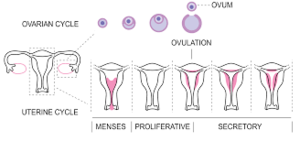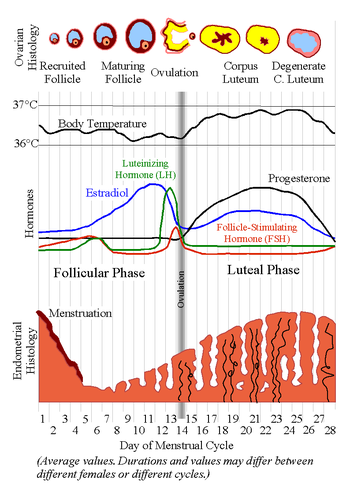Menstruation and Menstrual Rehab
Original Editor - Chelsea McLene
Top Contributors - Chelsea Mclene, Kirenga Bamurange Liliane, Sai Kripa, Kim Jackson, Khloud Shreif, Vidya Acharya, Candace Goh and Areeba Raja
Introduction[edit | edit source]
Menstruation, also known as a period is the process of discharging blood and other material from the lining of the uterus at regular intervals of about one lunar month from puberty until the menopause, except during pregnancy. The first period usually begins between twelve and fifteen years of age, a point in time known as menarche.
Each month, one of the ovaries releases an egg — a process called ovulation. At the same time, hormonal changes prepare the uterus for pregnancy. If ovulation takes place and the egg isn't fertilised, the lining of the uterus sheds through the vagina.[1]
Phases[edit | edit source]
The day count for menstrual cycle begins on the first day of menstruation when blood starts to come out of the vagina. The typical cycle is of 28 days. The cycle may be short as 21 days or long as 40 days.
There are 2 cycles to be understood.
- Uterine cycle - Menstrual phase, Proliferative phase and Secretory phase.
- Ovarian cycle - Follicular phase, Ovulation, Luteal phase.
1. Uterine cycle
MENSTRUAL PHASE (day 1-5)
Menstrual phase begins on the first day of menstruation and lasts till the 5th day of the menstrual cycle. The uterus sheds its inner lining of soft tissue and blood vessels which exits the body from the vagina in the form of menstrual fluid. Blood loss of 10 ml to 80 ml is considered normal. Abdominal cramps can be experienced. These cramps are caused by the contraction of the uterine and the abdominal muscles to expel the menstrual fluid. Shedding of endometrium oestrogen and progesterone are at the lowest levels.
PROLIFERATIVE PHASE (day 6-14)
There is maturation of graffian folllicles and secretion of oestrogen by theca interna of graffian follicle. Endometrial cells increase in number. There is increase in thickness of endometrium from 1mm to 4.6mm. Because of secretion of oestrogen, formation of new endometrial layer is initiated.
SECRETORY PHASE (day 15-28)
During the secretory phase, progesterone (as well as oestrogen) is secreted by the corpus luteum, which develops from the Graafian follicle. Progesterone secreted by the corpus luteum stimulates the further build-up of the cells in the endometrium of the uterus. It also stimulates the glands in the uterus to secrete substances that maintain the endometrium and keep it from breaking down. Thickness of endometrium further increases and the endometrial cells also increase in number. Smooth muscles show relaxation. Endometrium becomes receptive to implantation and thus supports early pregnancy.
2. Ovarian cycle
FOLLICULAR PHASE (day 1-13)
This phase also begins on the first day of menstruation, but it lasts till the 13th day of the menstrual cycle. The pituitary gland secretes a hormone that stimulates the egg cells in the ovaries to grow. One of these egg cells matures. While the egg cell matures, its follicle secretes a hormone that stimulates the uterus to develop a lining of blood vessels and soft tissue called endometrium.
OVULATION (day 14)
The pituitary gland secretes a hormone and causes the ovary to release the matured egg cell. The released egg cell is swept into the fallopian tube by the cilia of the fimbriae. Under the influence of LH surge the Graafian follicle ruptures and releases ovum.
LUTEAL PHASE (day 15-28)
This phase begins on the 15th day and lasts till the end of the cycle. Under the effect of pituitary hormone, FSH and LH causes development of corpus luteum and increases progesterone levels. The egg cell released during the ovulation phase stays in the fallopian tube for 24 hours. If a sperm cell does not impregnate the egg cell, the egg cell disintegrates and causes the menstrual phase of the next cycle to begin.[3]
Menstrual health and hygiene management[edit | edit source]
Menstrual health management is human right.[4] Women and adolescent girls must use clean menstrual management material to absorb or to collect the blood. soap and water must be used to cleanse and there must be proper facilities to dispose the used menstrual management material. Menstruation is a natural process, but in most parts of the world it is taboo. It has to be properly managed or it can result in health problems.[5]
Different menstrual products
Disposal methods
If the product used is reusable, clean it with water, sterilize and store it clean for the next use.
If it is disposable, use proper guidelines - disposal methods.
Menstrual Dysfunctions[edit | edit source]
- PREMENSTRUAL SYNDROME - It is unpleasant or uncomfortable symptom which includes hot flushes, vertigo, muscle cramps, breast soreness, acne, bloating, headache etc. Sudden fluctuation of hormones are responsible for this. It can sometimes be so severe that they will need to miss work or school.[6]
- POLYMENORRHOEA - Frequent menstruation at interval between 2-3 weeks. Blood loss is usually normal.[7]
- AMENORRHEA - Absence of menstrual period for more than 3 cycles. Causes include sudden weight loss, stress, PCOS or PCOD etc.[8]
- DYSMENORRHEA - It is characterized by severe pain, cramps during menstrual period. It includes 2 types; primary which means the common menstrual cramps due to uterine muscle contraction and secondary due to underlying pathology like endometriosis, adyneomyosis etc.[9]
- MENORRHAGIA - Excess or prolonged bleeding at regular interval.
- METRORRHAGIA - Irregular , heavy and intermenstrual bleeding.
- POLY CYSTIC OVARIAN SYNDROME - It is the hormonal and metabolic disorder. In this type, thee ovaries fail to release egg due to numerous small fluid filled follicles. Causes include excess insulin, heredity, excess androgen. Symptoms include excess weight gain, acne, prone to diabetes etc.[10]
- POLY CYSTIC OVARIAN DISORDER - symptoms are almost same as PCOS. Ovaries contain immature eggs which turn to cysts due to excess junk food consumption, stress or being overweight.[11]
- ENDOMETRIOSIS - It is a condition where endometrial tissue is outside the uterus. this leads to adhesion and scar tissue formation causing severe pain and discomfort. common symptoms are dysmenorrhia, pain on urinating and intercourse, excess bleeding etc.[12]
- MUSCULAR PAIN
- PELVIC FLOOR DYSFUNCTION - Chronic and severe menstrual pain may lead to spasm of pelvic floor muscle resulting in hypertonus dysfunction. Pelvic floor muscles may become tight leading to vaginismus, dysareunia etc.
- POST MENOPAUSAL BLEEDING - Bleeding from genital tract after menopause. Causes include malignancy, vaginitis, uterine prolapse etc.
Role Of Physiotherapy In Menstrual Rehabilitation[edit | edit source]
Management includes, two categories
- General management
- Pelvic floor rehab for menstrual disorders : This includes pelvic floor exercises.
General Management[edit | edit source]
This includes dietary management, exercise, modalities, stress management and yoga.[13]
Dietary Management[edit | edit source]
Avoid sugary diet, Excess raw meat, fried foods, fast food , soda, alcohol and caffeinated drinks. Food to be taken include green leafy vegetables, oats, avocado, broccoli, olives, walnuts, almonds, beans and lentils, legumes. Berries, Natural processed food like milk, butter and curds also can be taken. Fish oils, salmon, tuna have great health benefits and is good to take during menstruation.
Exercises and Modalities[edit | edit source]
Aerobics[14] and resisted exercise play major role here to reduce pain[15], discomfort.[16]
Modalities : TENS, Hot pack, Acupuncture, Acupressure ,Taping.[17][18]
Stress Management[edit | edit source]
Managing stress and anxiety is very important as it can cause negative effects on menstruation. Breathing exercise and relaxation techniques can help in great way to reduce stress and anxiety. Meditation also plays an important role to manage stress. It is important to develop some hobbies which will help to divert mind. Having bath with Luke warm water and Epsom salt also contributed to reduce stress levels.
Yoga[edit | edit source]
Different yoga poses like Bhujangasana, Malasana, Usthrasana, Baddha konasana and Dhanurasana help to ease pain and discomfort during menstruation.[19]
Pelvic Floor Rehab[edit | edit source]
Rehabilitation depends on the findings of pelvic floor muscle grade. Individuals with PCOS, endometriosis may have tightness of pelvic floor while lactating or individuals with low oestrogen may have weakness of pelvic floor muscles. It involves treating various menstrual irregularities.[21]
- Rehab includes : Mirror biofeedback, vaginal dilators, IFT, NMR, US.
- Soft tissue mobilisation.
- Lower limb stretches.
References[edit | edit source]
- ↑ Menstrual cycle. Mayo clinic. Available from https://www.mayoclinic.org/healthy-lifestyle/womens-health/in-depth/menstrual-cycle/art-20047186 [last accessed 06/10/2020]
- ↑ Menstrual cycle. Osmosis. Available from https://www.youtube.com/watch?v=tOluxtc3Cpw [last accessed 08/10/2020]
- ↑ Fletcher.J. Medical News Today. What are the phases of menstrual cycle? Available from https://www.medicalnewstoday.com/articles/326906 [last accessed 06/10/2020]
- ↑ Pitre.S. Innovations in health care. Menstrual health management is human right. [last accessed 06/10/2020]
- ↑ Menstrual hygiene. Environmental health group. Available from https://ehg.lshtm.ac.uk/menstural-hygiene/ [last accessed 06/10/2020]
- ↑ Premenstrual syndrome. Office of womens health. Available from https://www.womenshealth.gov/menstrual-cycle/premenstrual-syndrome#:~:text=Premenstrual%20syndrome%20(PMS)%20is%20a,bloating%2C%20headaches%2C%20and%20moodiness. [last accessed 08/10/2020]
- ↑ polymenorrhoea. Health line. Available from https://www.healthline.com/health/polymenorrhea#:~:text=Polymenorrhea%20is%20a%20term%20used,form%20of%20abnormal%20uterine%20bleeding. [last accessed 08/10/2020]
- ↑ Amenorrhea. Mayo clinic. Available from https://www.mayoclinic.org/diseases-conditions/amenorrhea/symptoms-causes/syc-20369299#:~:text=Amenorrhea%20(uh%2Dmen%2Do,cause%20of%20amenorrhea%20is%20pregnancy. [last accessed 08/10/2020]
- ↑ Dysmenorrhea. Cleaveland clinic. Available from https://my.clevelandclinic.org/health/diseases/4148-dysmenorrhea#:~:text=Dysmenorrhea%20is%20the%20medical%20term,Dysmenorrhea%20Menu [last accessed 08/10/2020]
- ↑ PCOS. Mayo clinic. Available from https://www.mayoclinic.org/diseases-conditions/pcos/symptoms-causes/syc-20353439#:~:text=Polycystic%20ovary%20syndrome%20(PCOS)%20is,fail%20to%20regularly%20release%20eggs. [last accessd 08/10/2020]
- ↑ PCOD. Columbio Asia . Available from https://www.columbiaindiahospitals.com/health-articles/what-polycystic-ovarian-disease-pcod-causes-treatment#:~:text=Polycystic%20Ovarian%20Disease%20(PCOD)%2C,difficult%20for%20her%20to%20conceive. [last accessed 08/10/2020]
- ↑ Endometriosis. Body and mind. Available from https://www.whiteswanfoundation.org/mental-health-matters/body-and-mind/endometriosis-the-emotional-impact-of-physical-pain [ last acceseed 08/10/2020]
- ↑ Jesspreale. Can physical therapy help menstrual cramps? Available from https://jessicarealept.com/2017/06/14/can-physical-therapy-help-menstrual-cramps/ [last accesed 08/10/2020] [last accessed 28/09/2020]
- ↑ Dehnavi ZM, Jafarnejad F, Kamali Z. The Effect of aerobic exercise on primary dysmenorrhea: A clinical trial study. J Educ Health Promot. 2018;7:3. Published 2018 Jan 10. doi:10.4103/jehp.jehp_79_17
- ↑ Lee, J. W., & Park, H. S. Relation of the factor to menstrual pain and musculoskeletal pain. Journal of exercise rehabilitation., 11(2), 108–111. https://doi.org/10.12965/jer.150188
- ↑ Kannan P, Claydon LS. Some physiotherapy treatments may relieve menstrual pain in women with primary dysmenorrhea: a systematic review. J Physiother. 2014 Mar;60(1):13-21. doi: 10.1016/j.jphys.2013.12.003. Epub 2014 Apr 24. PMID: 24856936.
- ↑ Choi JH. Effects of kinesio taping and hot packs on premenstrual syndrome in females. Journal of Physical Therapy Science. 2017;29(9):1514-7.
- ↑ Lim C, Park Y, Bae Y. The effect of kinesio taping on menstrual pain and premenstrual syndrome. J Phys Ther Sci. 2013;25(7):761-764. Doi:10.1589/jpts.25.761
- ↑ Chethana Prakasan. Regulate your periods with yoga: 5 yoga asanas to regulate your irregular menstrual cycle naturally. published may,15 2017.4:06 PM IST
- ↑ SarahBethYoga. 15 min yoga for women during periods. Available from https://www.youtube.com/watch?v=awrZtZ49_bg [last accessed 12/10/2020]
- ↑ What are common treatments for menstrual irregularities? Eunice Kennedy Shriver National Institute of child health development. [last accessed 06/10/2020]








